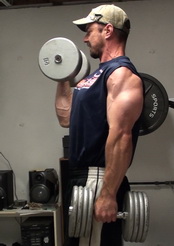There are two main problems that people run into with the Front Squat...
1. The core tends to fold over as the weight gets heavier or as you support the weight for higher rep sets.
2. The shoulders (front delts especially) fatigue faster and the bar starts to roll forward, which makes the core support fatigue faster as well.
Both of these problems will compromise your form on the Front Squat and limit the amount of work you can put on your legs.
This band "position spotting" technique is going to help you address those two deficits by changing how the bar tends to roll on your shoulders.
This simple tweak doesn't make the exercise easier...it makes it HARDER by allowing you to maintain better body position during the Front Squat, so you can get more reps and use more weight to challenge your legs more effectively.
And don't think for a second that this technique does the work of supporting the bar for you...far from it. It's essentially using band tension to counter the tendency of the bar to roll forwards and instead making the bar want to roll backwards, towards your neck (which is what we want).
And don't worry about not getting enough front delt or core work when you use this technique...because you can use more weight and get more reps, those weak points actually get MORE work than they do on regular Front Squats.
How to Do Band Position Spotted Front Squats
To do this, you'll need a thin 42-inch band.
This is the online store where I get my training bands.
I HIGHLY recommend investing in a few of these. Bands are among the most versatile training tools I have in my arsenal. I generally don't use them on their own as resistance but to add, subtract or change the direction of resistance. They fit in any gym bag and very portable.
Use a light weight the first time you try this setup.
First, drape the band over the bar like you're laying a towel over to dry.

The loops should be even, with the bands contacting the bar about 4-5 inches outside the smooth center area.

Grab both loops of the bands and stretch it.

Now place the loops of the bands over your head and around the back of your neck.

Keep the bands stretched then raise both arms up.

Bring your arms down and INSIDE the band loops so they're pressing on your triceps.

Bring your hands underneath the bar.

Then get into position as you normally would for the exercise. I'm using a cross-arm racking style here. I haven't tried this technique with a "clean" racking style, but I think it would still work. If you try it like that, let me know how it works for you.

As you can see in the pic, with the band looped around your neck, it's pulling the bar backwards towards your neck. And with the band going underneath your arms, it provides support to the front delts so they don't fatigue as readily and tip your torso forward.
Once you're set, unrack, step back and squat.

You'll immediately notice that you're able to maintain better body position during the exercise.

Now that you've learned the technique, you can incorporate it into your regular leg traning!
Honestly, the first time I tried this Band Spotted Front Squat technique, I was very impressed.
It looks a bit bizarre, to be sure, but the immediate improvement in body position makes it something worth trying out for yourself, especially if building your Front Squat is important to you.
And if you've had issues with Front Squats before because of body position deficits, this might just get you back on the wagon and get you back to what is one of the best exercises you can do for total body strength and power.
---
Are you 40...50...60 or even 70+ years old and want to build muscle and strength like you did 20 years ago?
If you feel like you're fighting a losing battle, you're ready to discover the REAL secret to REVERSING muscle loss due to aging...
*** You need to train the body systems that SUPPORT your muscle mass, not just the muscle itself. ***
These underlying support systems diminish as you age, which is why you lose muscle as you get older no matter how hard you train... but with strategic training, these systems can be regenerated.
Share This Page...
Want More Strength-Building Techniques and Programs?
You'll find them here...



